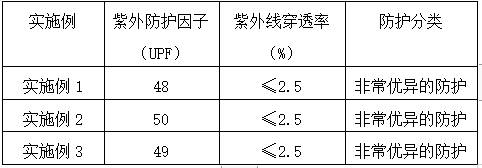An olive anti-attenuation high-strength pp spunbonded nonwoven fabric
A technology of spunbonded non-woven fabrics and olive resistance, which is applied in the direction of non-woven fabrics, textiles and papermaking, fiber chemical characteristics, etc., can solve the problems of weak filtration rate, weak oxidation resistance and static electricity of the outer spunbonded non-woven fabrics. Adsorption capacity decline and other problems, to achieve the effect of prolonging the electrostatic adsorption time, good antibacterial performance, sphericity and good dispersion
- Summary
- Abstract
- Description
- Claims
- Application Information
AI Technical Summary
Problems solved by technology
Method used
Image
Examples
Embodiment 1
[0050] Embodiment 1 A kind of preparation method of olive anti-attenuation high-strength PP spunbonded nonwoven fabric, comprising:
[0051] The polypropylene high polymer is melted and extruded through a large screw extruder, filtered, spun, air-drawn and stretched to lay the filaments into a web, and the fiber web is passed through the upper and lower pressure rollers, and the rolling mill is hot-rolled and bonded to form a spun-bonded non-woven fabric. Spinning, and finally winding, cutting, prepared into PP spunbond non-woven fabric;
[0052] Specifically include the following steps:
[0053] 1. Add polypropylene and polypropylene masterbatch to the large screw extruder according to the mass ratio, and the amount of the modified polypropylene masterbatch accounts for 1% of the total mass of the spunbond nonwoven fabric in terms of olive leaf extract ;First heat to 90°C in the first zone mixing stage, mix at medium speed for 25 minutes, then add modified polypropylene mast...
Embodiment 2
[0077] Embodiment 2 A kind of preparation method of olive anti-attenuation high-strength PP spunbonded nonwoven fabric, comprising:
[0078] The polypropylene high polymer is melted and extruded through a large screw extruder, filtered, spun, air-drawn and stretched to lay the filaments into a web, and the fiber web is passed through the upper and lower pressure rollers, and the rolling mill is hot-rolled and bonded to form a spun-bonded non-woven fabric. Spinning, and finally winding, cutting, prepared into PP spunbond non-woven fabric;
[0079] Specifically include the following steps:
[0080] 1. Add polypropylene and modified polypropylene masterbatch to the large screw extruder according to the mass ratio, and the amount of the modified polypropylene masterbatch accounts for 10% of the total mass of the spunbonded nonwoven fabric in terms of olive leaf extract 2%; first heat to 80°C in the mixing stage of zone 1, mix at medium speed for 20 minutes, then add modified poly...
Embodiment 3
[0104] Embodiment 3 A kind of preparation method of olive anti-attenuation high-strength PP spunbonded nonwoven fabric, comprising:
[0105] The polypropylene high polymer is melted and extruded through a large screw extruder, filtered, spun, air-drawn and stretched to lay the filaments into a web, and the fiber web is passed through the upper and lower pressure rollers, and the rolling mill is hot-rolled and bonded to form a spun-bonded non-woven fabric. Spinning, and finally winding, cutting, prepared into PP spunbond non-woven fabric;
[0106] Specifically include the following steps:
[0107] 1. Add polypropylene and modified polypropylene masterbatch to the large screw extruder according to the mass ratio, and the amount of the modified polypropylene masterbatch accounts for 10% of the total mass of the spunbonded nonwoven fabric in terms of olive leaf extract 3%; first heat to 120°C in the mixing stage of zone 1, mix at medium speed for 40 minutes, then add modified pol...
PUM
| Property | Measurement | Unit |
|---|---|---|
| strength | aaaaa | aaaaa |
| strength | aaaaa | aaaaa |
| melt flow index | aaaaa | aaaaa |
Abstract
Description
Claims
Application Information
 Login to View More
Login to View More - R&D
- Intellectual Property
- Life Sciences
- Materials
- Tech Scout
- Unparalleled Data Quality
- Higher Quality Content
- 60% Fewer Hallucinations
Browse by: Latest US Patents, China's latest patents, Technical Efficacy Thesaurus, Application Domain, Technology Topic, Popular Technical Reports.
© 2025 PatSnap. All rights reserved.Legal|Privacy policy|Modern Slavery Act Transparency Statement|Sitemap|About US| Contact US: help@patsnap.com



